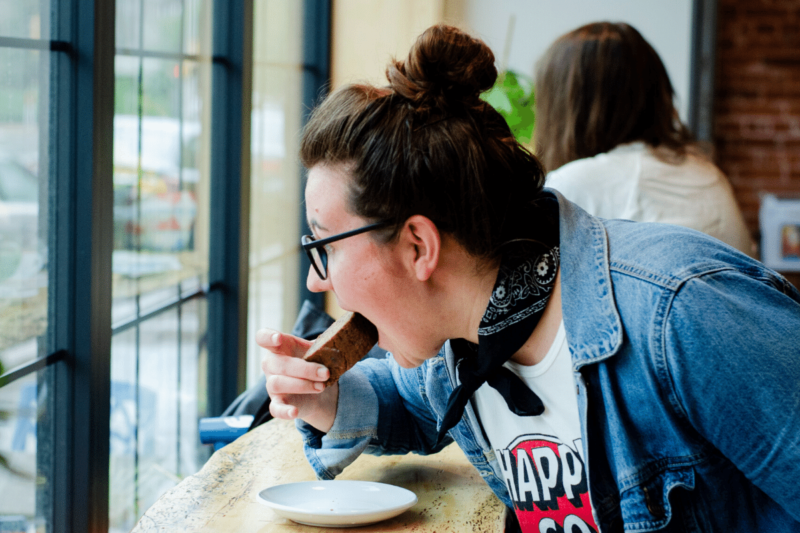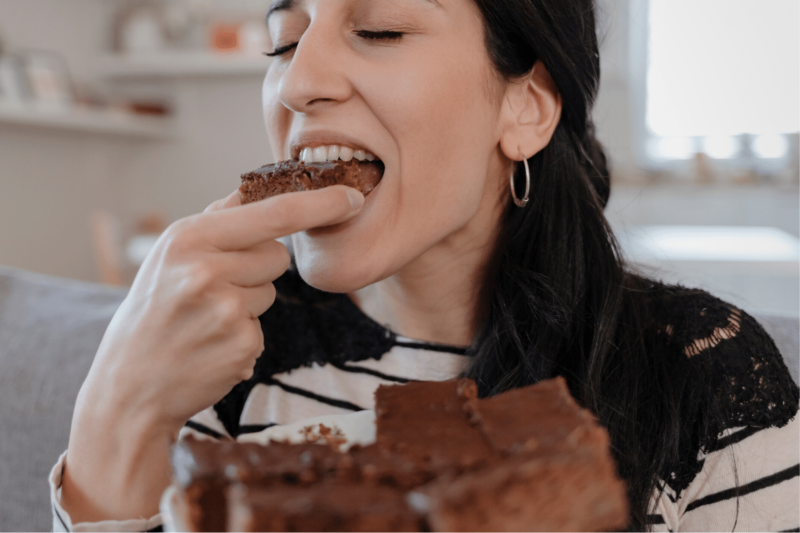
In my previous post, I mentioned that habituating to forbidden foods can feel challenging. While making peace with food involves some mental aspects, to take it all the way and habituate to food means actually practicing eating those foods. The challenge is often due to some common obstacles.
One is the fear you won’t stop eating. The reality is that you will stop eating once habituation happens. And by stop eating, I don’t mean never eating that food again. (This isn’t about eating so much of a food that you get sick of it…a la Lucy and Ethel in the chocolate factory.) I mean that you can eat it an uncomplicated way.
- Sometimes you might want a little of it, sometimes you might want a lot of it.
- Sometimes you might think you want some then realize you really don’t, maybe because you realize you’re full and satisfied and more food would just burst your satisfaction bubble.
- Sometimes you might forget about the food and not have it for months, then one day you do think about it and say, “Wow, I haven’t had that in forever.” And you eat some, and it’s lovely.
In the beginning, when you are not habituated to a food and you aren’t 100% convinced that you can really have that food whenever you want it (so you still have a fear of deprivation), this can lead to “Last Supper” eating, and that can feel chaotic or even scary. But, again, that’s just because you’re not habituated yet.

Getting all caught up in your head
Then there’s the self-fulfilling prophecy of thinking “I’ve tried to make peace with this food, to give myself unconditional permission to eat it, and it didn’t work.” Keep thinking that it won’t work, and no, it probably won’t work. But what may have actually happened when it “didn’t work” is that you only gave yourself pseudo-permission. Or that you just, again, weren’t habituated yet.
Or, you might worry that if you allow yourself to have foods you previously deemed “bad,” that you won’t eat healthfully.
It’s true that you might need to set ideas about what “good nutrition” should look like aside for a bit while you work on making peace with other foods. However, over time, your food choices will balance out.
Also, you might feel like you’re eating nothing but cookies because it feels weird to allow yourself cookies after lunch AND dinner, but if you really look at what you’re eating, I bet you’re eating other stuff too, stuff that is in fact nutritious.
One of the biggest obstacles can simply be not trusting yourself. This feeling can be the result of years of dieting, which teaches you to trust the diet rules rather than yourself. It may also stem from early childhood experiences.
If your parents had a lot of food rules and you weren’t allowed to regulate your own eating, then of course it’s hard to trust yourself. If you don’t trust your body, generally (as can be the case with survivors of physical or sexual trauma), it can be hard for you to trust yourself around food, too.

Know before you go
How do you know if and when you’re ready to start habituating to forbidden foods? The first step is to make sure that you are able to tune into your hunger and feel the difference between gentle hunger and ravenous, primal hunger. (Practicing habituation when you could eat the tabletop, whether you know it or not? Not a good idea.)
You should also be able to notice when you’re becoming gently full. If you find it hard to know you’re full until you’re really full (i.e., stuffed), then sitting down to eat a food you’ve held at arm’s length for a long time may lead to eating to the point of uncomfortable fullness.
So if you have trouble tuning into hunger and fullness, that might be a more important thing for you to work on right now. And if you can’t tolerate uncomfortable fullness without trying to compensate by skipping meals or compulsively exercising, then making peace with specific forbidden foods should definitely stay on the back burner for now.
Also, if you find it difficult to experience satisfaction from food, period, then trying to habituate to a forbidden food will probably feel too challenging right now. Maybe you’re still following a diet that you don’t enjoy (whether for weight loss or for wellness). Maybe you feel guilt when you enjoy your food. “Discover the Satisfaction Factor” is the hub of the Intuitive Eating wheel, so that may be a better area of exploration for you.

Setting the stage
What if you can ID hunger and fullness relatively easily, and find satisfaction from everyday foods you eat for breakfast, lunch and dinner? Then the next step is to choose a time when you aren’t stressed, tired, or looking to soothe emotions.
Also, make sure you can really sit and enjoy the food you’re trying to habituate to. Don’t be in a rush, don’t be in a place where there are major distractions or where you’re likely to be interrupted.
You can do this practice at home, or if that feels a little too scary, you can do what a number of my clients have done, and buy a single portion of your chosen food and eat it away from home.
For example, one of my clients was convinced she was addicted to sugar, and that if she had a whole dessert in her house (a carton of ice cream would count), she would eat it all. So she ordered a serving of dessert when she was out with her partner, and allowed herself to enjoy as much of it as she wanted. Today, she can bake delicious desserts and have them in her home stress-free (hint: she wasn’t really addicted to sugar).
Ready to practice habituating to food?
When you choose the specific food you want to habituate to, be specific about the brand, if applicable, and the flavor. Once you sit down, pay attention to any feelings coming up before you take the first bite. Excitement? Worry? Curiosity about what will happen?
While eating, pay attention to the sensory aspects of the food. Taste. Texture. Temperature. Aroma. Is the food meeting your expectations? When you’re done eating, ask yourself again if the experience was what you thought it would be. Did anything surprise you? What would you do differently next time?
Next time? Yes, next time. Habituating to a food that you’ve long labeled as “off limits” often requires multiple exposures before you get to the, “Yes, I like this food, and I know I can have it when I want it, but right now I want something else” stage. As with the bagel story in my previous post.
For more specific tips and checklists, refer to the “Make Peace With Food” chapters in the books “Intuitive Eating” and “The Intuitive Eating Workbook.”
This post contains Amazon Affiliate links. As an Amazon Associate I earn from qualifying purchases.
Disclaimer: All information provided here is of a general nature and is furnished only for educational purposes. This information is not to be taken as medical or other health advice pertaining to an individual’s specific health or medical condition. You agree that the use of this information is at your own risk.
Hi, I’m Carrie Dennett, MPH, RDN, a weight-inclusive registered dietitian, nutrition therapist and body image counselor. I offer compassionate, individualized care for adults of all ages, shapes, sizes and genders who want to break free from eating disorders, disordered eating or chronic dieting. If you need to learn how to manage IBS symptoms with food, or improve your nutrition and lifestyle habits to help manage a current health concern or simply support your overall health and well-being, I help people with that, too.
Need 1-on-1 help for your nutrition, eating, or body image concerns? Schedule a free 20-minute Discovery Call to talk about how I can help you and explore if we’re a good fit! I’m in-network with Regence BCBS, FirstChoice Health and Providence Health Plan, and can bill Blue Cross and/or Blue Shield insurances in many states. If I don’t take your insurance, I can help you seek reimbursement on your own. To learn more, explore my insurance and services areas page.
Want exclusive content on nutrition, health, diet culture and more, plus critiques of nutrition and health journalism? Subscribe to my Food Noise newsletter! 📣
 Print This Post
Print This Post






